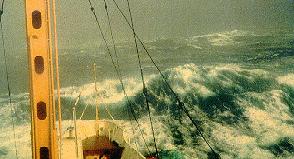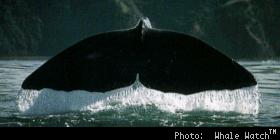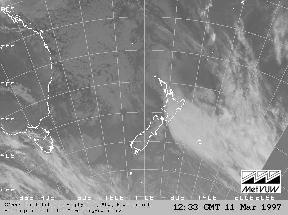
The weather has been quite unkind to us for the past 5-6 days, with the winds continuously strong enough to whip the sea into a constant state of agitation So, the sea has been too rough to work on, at least at the surface.
 That means the Crittercam, the
instrument cylinder with video camera, thermometer, sound and depth
recorders, releasing mechanisms and radio beacon, can not be deployed
on the sperm whales. How disappointing and frustrating, because we
have planned and worked so hard to get the permits and to demonstrate
the benign nature of this research package that has so much potential
for gathering data vital to the understanding of the biology and
behavior of the whales.
That means the Crittercam, the
instrument cylinder with video camera, thermometer, sound and depth
recorders, releasing mechanisms and radio beacon, can not be deployed
on the sperm whales. How disappointing and frustrating, because we
have planned and worked so hard to get the permits and to demonstrate
the benign nature of this research package that has so much potential
for gathering data vital to the understanding of the biology and
behavior of the whales.
Among the primary objectives of the Crittercam
study is to collect video images of sperm whales' hunting and feeding
behavior to learn where and how they locate and capture their prey and
to document what their prey species are. Among the prey we know about,
of course, is the giant squid, the species that has been one of the
driving motives behind the whole expedition. It always has been
elusive to human observers, and it continues to be elusive even now!
 The one break in the
strong winds the other day enabled Greg Marshall, the inventor of the
Crittercam, and Randy Davis, a whale expert, to cautiously paddle their
yellow inflatable sea kayak right up beside a big whale. He was as
unconcerned as one of the millions of sheep grazing on New Zealands
hillsides! That gives us confidence that well be able to work with
these whales to gain insights into their lives. And that can help
insure that these magnificent animals will continue to cruise their
ocean domain forever.
The one break in the
strong winds the other day enabled Greg Marshall, the inventor of the
Crittercam, and Randy Davis, a whale expert, to cautiously paddle their
yellow inflatable sea kayak right up beside a big whale. He was as
unconcerned as one of the millions of sheep grazing on New Zealands
hillsides! That gives us confidence that well be able to work with
these whales to gain insights into their lives. And that can help
insure that these magnificent animals will continue to cruise their
ocean domain forever.
![]() A comprehensive description of the Crittercam including a short video taken by the Crittercam, is available on the National Geographic Society's Kaikoura Web Site.
A comprehensive description of the Crittercam including a short video taken by the Crittercam, is available on the National Geographic Society's Kaikoura Web Site.
 I sit in the Giant Squid Expedition headquarters (the Panorama Motel)
waiting for the latest weather report. Cyclone Gavin ravaged Fiji a few days ago, then decided to visit New Zealand, coming close ashore on the North Island last night, wreaking havoc along the northeast coast. If the storm continues to move with a
southerly component, as is predicted, we surely will feel the effects
of it on South Island here in Kaikoura. Though tropical storms on
shore are rare here, there can be the fringe effects of high winds,
heavy rains, rough seas and high water.
I sit in the Giant Squid Expedition headquarters (the Panorama Motel)
waiting for the latest weather report. Cyclone Gavin ravaged Fiji a few days ago, then decided to visit New Zealand, coming close ashore on the North Island last night, wreaking havoc along the northeast coast. If the storm continues to move with a
southerly component, as is predicted, we surely will feel the effects
of it on South Island here in Kaikoura. Though tropical storms on
shore are rare here, there can be the fringe effects of high winds,
heavy rains, rough seas and high water.
![]() As our headquarters are only a
meter or so above the high tide mark and 17 meters from the sea, we
could be in for an interesting time. Actually, with the winds we've had
out of the northeast in the past few days, the waves sweep unbroken
right into Kaikoura Bay. They crash onto the rocks 50 meters off the
shore at low tide, but at high tide they sweep right in and burst into
the embankment that forms the edge of the road. Rocks and seaweed are
tossed up onto the road, along with an abundance of small marine life,
which leaves easy pickings for the sea gulls and herons that patter
along the tarmac pecking up tidbits. Not often you see these species
of birds feeding on a main road!
As our headquarters are only a
meter or so above the high tide mark and 17 meters from the sea, we
could be in for an interesting time. Actually, with the winds we've had
out of the northeast in the past few days, the waves sweep unbroken
right into Kaikoura Bay. They crash onto the rocks 50 meters off the
shore at low tide, but at high tide they sweep right in and burst into
the embankment that forms the edge of the road. Rocks and seaweed are
tossed up onto the road, along with an abundance of small marine life,
which leaves easy pickings for the sea gulls and herons that patter
along the tarmac pecking up tidbits. Not often you see these species
of birds feeding on a main road!
I'm afraid the upshot of the threatening weather is that well continue to be locked on shore, unable to continue our research into the depths of Kaikoura Canyon. If this situation remains it will be an unfortunate and frustrating way to have to complete the expedition. I'd rather finish up on the last day just at dusk with the spray in our faces, the moon rising as the sun sinks below the mountains, knowing we had given it all we had. We'll see.
![]()
Smithsonian Giant Squid Overview Page
gene carl feldman / gene@seawifs.gsfc.nasa.gov